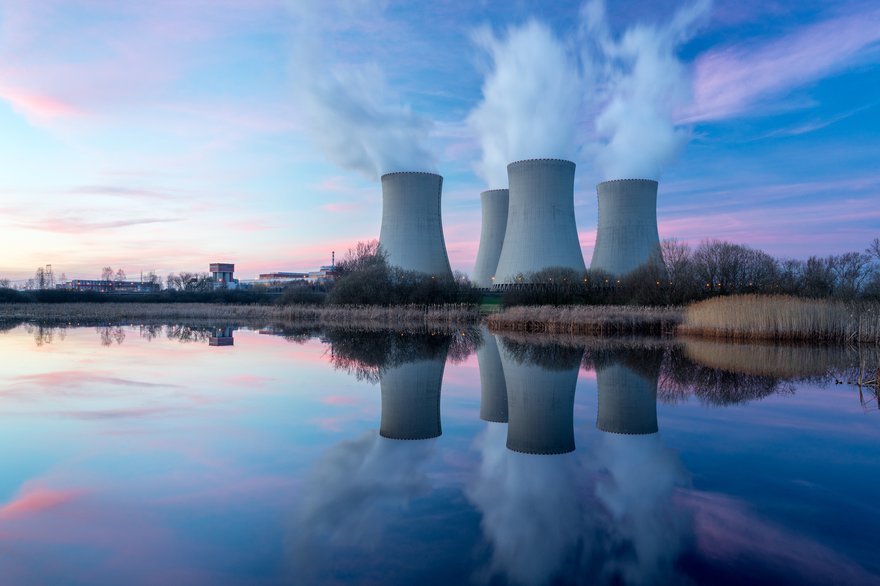Nuclear energy stocks have become far more compelling to many investors in recent years. Between the implications of climate change, the limits on solar and wind energy and storage technology, the still-high costs of hydrogen energy, and decades of data that support nuclear energy as safe, there are good reasons to support this carbon-free source of energy.
But before jumping into the latest hot nuclear energy stock, it pays to know what you're getting into. In this article, we will break down the nuclear energy industry, opportunities, risks, and what investors need to understand.

Understanding nuclear energy
Understanding nuclear energy
Without diving too deep into the science, nuclear energy, in general, refers to fission. Fission is the process of splitting the nucleus of atoms, releasing significant energy (heat and radiation) that starts a chain reaction, continuing as long as there's fuel.
It's the release of heat in this reaction that's important. A cooling agent -- almost always water -- is heated by fission, and the steam generated by the heat powers turbine generators. That creates electricity.
The fuel for almost all nuclear fission is uranium-235, the isotope that can produce a fission chain reaction. Getting this radioactive material out of the ground and transported safely to customers isn't something just any old mining company does. As a result, most uranium mining companies are fairly specialized.
But mining is only the first step in getting a product usable by the market. Uranium-235 makes up a tiny portion of the uranium found in nature. More than 99% of the world's supply is uranium-238, which can't produce a fission chain reaction and has to be "enriched" into uranium-235. This is a lucrative business for the small number of companies that do it.
Producing power from nuclear energy also requires a nuclear power plant, called a reactor. There are only a small handful of companies with the expertise and financial strength to deal with nuclear reactors, and almost all are either private, state-owned, or the subsidiary operation of a large industrial conglomerate. These companies generally build the reactors, as well as provide maintenance and other necessary services for the many decades a nuclear reactor is in operation.
Historically, commercial nuclear reactors have been very large in scale to maximize efficiency since smaller-scale reactors could not compete on efficiency. But that's potentially on the verge of change, with newer innovations making nascent small-scale nuclear reactors more compelling.
Looking beyond fission, there have been major advances in nuclear fusion in recent years. Long considered the "holy grail" of energy, fusion is, to quote the International Atomic Energy Agency, "the process by which two light atomic nuclei combine to form a single heavier one while releasing massive amounts of energy."
What makes it so compelling: Fusion could provide -- again, quoting the IAEA -- "virtually limitless clean, safe and affordable energy to meet the world's energy demand." The problem: It's incredibly hard; we are talking about the equivalent of making miniature suns, after all. But the upside is almost immeasurable and explains why decades of research and virtual mountains of money have been invested in it. Fusion would be significantly safer and cleaner than any other source of energy under humanity's control today. The question we still don't know the answer to is how many more decades before it's more than just an expensive experiment, much less anywhere close to commercially viable.
And we need more clean energy now. Back to fusion. After many years of negative sentiment, nuclear energy is back on the table -- for good reasons, based on its clean-energy bona fides and relatively solid safety record that has been marred by a small number of high-profile events.
Up next, let's take a closer look at three top nuclear energy stocks.
Three top nuclear energy stocks
Three top nuclear energy stocks
1. Cameco
One of the few well-established pure-play companies to invest in nuclear energy stocks, Cameco (CCJ 0.39%) is one of the world's largest uranium miners and refiners. This Canadian company's Cigar Lake facility produces the world's highest-grade uranium and has produced more than 100 million pounds since going online in 2015, while its McArthur River/Key Lake was brought back into operation in 2022 after being shut down for several years.
Cameco also produces uranium hexafluoride and uranium dioxide, which are used in uranium enrichment and fuel rod production.
Like many other natural resources companies, Cameco is heavily affected by the cyclical pricing of the underlying commodities it produces and sells. As a result of these commodity swings, it can be a very cyclical stock, going through boom-and-bust periods when its earnings can spike and then fall sharply before recovering again. The good news is that, despite this cyclical reality, Cameco has a long track record of generating strong positive operating cash flow. Between 2010 and mid-2023, Cameco generated positive operating cash every rolling four-quarter period with only one exception.
At this writing, Cameco stock isn't cheap, trading near its all-time high, and earnings and cash flow multiples you'd easily confuse with those of Nvidia (NVDA 6.18%). But for patient investors, Cameco is worth putting on your watchlist. There is growth potential as the number of fusion reactors returns to growth over the next decade, and its track record makes it worth considering at the right price.
2. General Electric
Let's make no bones about it: General Electric (GE 0.68%) has been a good investment since mid-2022 but has generally not been good to shareholders for the previous two decades. However, GE has been in the nuclear power business since the 1950s and is one of a handful of companies with significant market share in nuclear reactors.
Plus, there are things happening at GE that could make it far more appealing if you're looking for exposure to nuclear energy. The company is in the process of spinning off several of its business units into stand-alone companies that should be far more competitive -- and appealing to investors -- on their own.
One of these future spinoffs will be called GE Vernova, which will include all of the current company's GE Power business units. This includes GE's nuclear business, which was spun into a joint venture with Japanese industrial giant Hitachi in 2007.
There are a few things that make this future GE spinoff a compelling nuclear energy stock to me. First, I do believe that GE's spinoff plans will indeed create value. Much of GE's struggles over the past two decades have been caused by its sprawling structure, leading to conflicts between business units and management's poor allocation of capital across the enterprise. A stand-alone, energy-focused company should solve much of this problem while also giving investors exposure to a cross-section of the world's current and future energy sources. Beyond GE Hitachi Nuclear Energy, the nuclear reactors and services spinoff, investors will also get exposure to GE's leading gas, hydroelectric, and steam power technologies and its leading onshore and offshore wind energy business.
That's a diversified business, one that's also targeted squarely at both today's and tomorrow's energy needs.
Investors must be patient, however. GE plans to spin Vernova off as a stand-alone business in early 2024. Investors who buy GE shares before the separation will receive a distribution of Vernova shares when the spinoff happens; if you want to wait, you'll be able to buy GE Vernova shares on the market post-spinoff.
3. Brookfield Renewable
Like GE, this isn't a pure-play nuclear energy stock. Brookfield Renewable (BEPC 0.09%) owns, operates, and invests in hydroelectric, wind, solar, and energy storage facilities today, but it -- along with a group of institutional investor partners -- is in the process of acquiring a controlling stake in Westinghouse, one of world's largest nuclear services companies.
It is buying Westinghouse from Brookfield Business Partners (BBU 0.79%). No, the name isn't a coincidence; Brookfield Business acquired Westinghouse out of bankruptcy a number of years ago and is ready to move on, while Brookfield Renewable has a long track record as an operator in the renewable energy space.
Brookfield Renewable would have a 17% economic interest in Westinghouse, while its institutional partners will own 34%. This is the first move into nuclear energy for Brookfield Renewable, but it's not the first time it has spread its wings and diversified. Historically focused on hydroelectric, it moved heavily into wind and solar in the mid-2010s and has more recently begun investing in energy storage. With nuclear now on the menu, the takeaway is that Brookfield has a long, solid legacy of moving into nascent and formerly out-of-favor technologies when there's a clear path to profits. And I think that's the case with its investment in Westinghouse.
It's also got another big nuclear player in its corner, too. The other 49% of Westinghouse is being acquired by another company discussed here: Cameco.
Investors looking for more pure-play nuclear companies may be disappointed with the Brookfield pick, preferring a company like NuScale (SMR 2.89%), the startup that's trying to take small-scale reactors commercial.
And while NuScale could prove a huge winner, it's still very early in its existence. It went public via a special purpose acquisition company (SPAC) in May of 2022 and isn't likely to have its first "VOYGR" small modular reactor (SMR) power plant fully operational in the U.S. until 2030.
Instead of betting on a very unproven "next big thing" so far ahead of commercialization, investors looking to win from nuclear should consider proven winners like Brookfield Renewable first.
Related investing topics
Should you invest?
Should you invest in nuclear energy?
There are certainly reasons why nuclear energy stocks might sound compelling. After decades of being out of favor, nuclear energy is hanging out with the popular kids again. And that's likely to be good for the world since more low-carbon energy should result in more economic opportunity, a better environment, and better health outcomes for billions of people. Nascent technologies like small-scale reactors might be appealing, too.
But before piling into nuclear energy stocks, make sure to check your biases and your reasoning. As a cyclical industry that's come back into favor, the headlines (and message boards) can make it feel like a can't-miss opportunity. But that's far from the reality; while the secular trends look favorable, today's profits can turn into losses before you can say, "But what about last quarter?" So step lightly and consider the risks before you buy.
Nuclear energy stocks FAQs
What is nuclear energy?
Nuclear energy is the energy that is produced from either the chain reaction of splitting (fission) atoms, or the combining (fusion) of light atoms into heavier atoms.
Fission is the only commercially viable source of nuclear energy to date, and the heat it releases is used to generate steam to power turbines.
What is the leading company in nuclear energy?
Nuclear energy only has a small number of global players, and two companies are major leaders: Cameco is one of the largest producers of uranium and uranium products used to make nuclear fuels, while Westinghouse is one of the largest providers of equipment, parts, and services to the global fleet of nuclear reactors in operation.

















